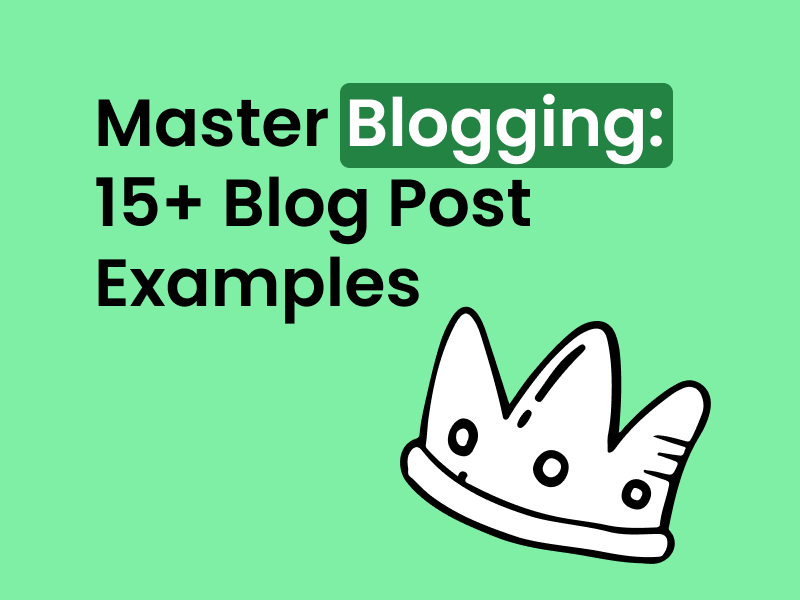How to Find the Right Blog Niche in 2023: 101 Blog Ideas to Write About
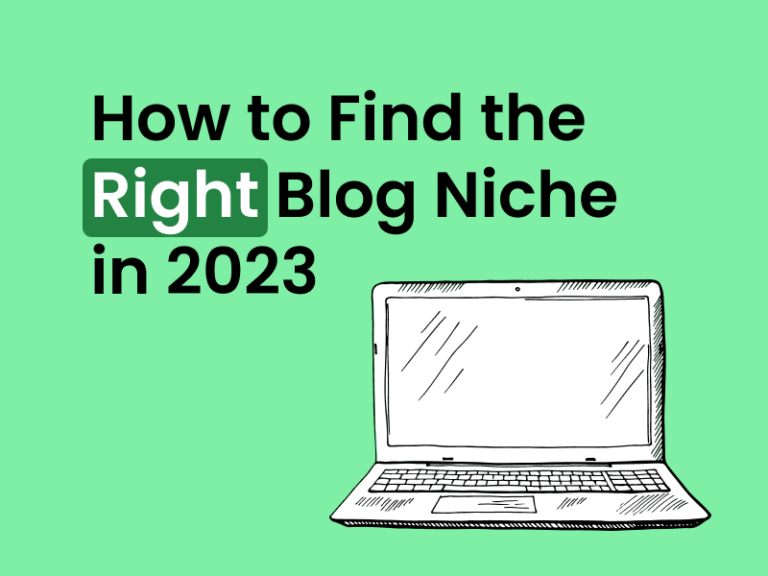
By Melissa Ng | Last Updated 3 November 2023
Introduction to Blog Niches
What is a Blog Niche?

A blog niche is essentially the main theme or subject matter of your blog. It’s the specialised topic area that all your blog content will revolve around. In practice, it’s the embodiment of your blogging ideas. In simplest terms, it’s what you’re going to write about, a good blog niche lends purpose, structure, and relevance to your blogging efforts.
Ensuring you consistently produce content that resonates with your intended audience is crucial, and one way of doing this is having a well-thought-out blog name that captures your niche effectively. Once you’ve narrowed down a couple of blog name ideas that interest you, you might find it beneficial to research them online, see who else is using similar names and how they’re making an impression with their audience.
Why Choosing the Right Blog Niche is important?

Choosing the right blog niche is crucial for several reasons. For starters, it not only streamlines your data-driven marketing entrepreneurship efforts, making them exponentially effective, but also plays a pivotal role in your brand’s identity establishment. It sets up a platform for delivering valuable, authoritative, and trustworthy information to your audience, thereby escalating their engagement with your business blogs.
As Opyhr Hanan, a renowned Blog Growth and SEO Outreach Specialist, appropriately mentions, “Blogging is a vital source of content that…adds value to users by providing them with information that will help them throughout their user journey.” Great emphasis should be placed on selecting a niche in line with your passions and areas of expertise, since such factors significantly influence the blog’s popularity and success rate.
Understanding Your Expertise and Audience
Listing Your Interests and Skills

To begin understanding your expertise and identifying potential blog niches, start by listing out your interests and skills. For instance, if you feel a spark of enthusiasm when it comes to gardening, jot that down under interests; this could hint towards a gardening niche for your blog.
Write down everything you feel passionate about, from hobbies to career skills. It could range from baking, decorating, graphic design, coding, or even travel planning. Don’t restrict yourself. The broader your list, the better. Next, identify skills you’ve acquired over the years. These can be technical skills, but soft skills like communication, creativity, empathy, etc., also matter.
Keep in mind, it’s essential to choose a niche you’re genuinely interested in — there should be some degree of joy and enthusiasm behind your blog. This comprehensive list will serve as a foundation to establish potential home blog ideas or niches that you have both interest and proficiency in.
Identifying your Potential Readers

After listing your interests and skills, it’s time to identify who will be most interested in your content — your potential readers. To effectively address this, consider their demographics, interests, and problems that you can help solve with your blog.
Are you attracting millennials looking to learn about personal finance, or unravel mysteries of investing? Or, are they young parents seeking creative ideas for DIY crafts or even simple, delicious recipes? Maybe, they’re professionals trying to develop new skills or people actively seeking self-care knowledge to boost their overall wellbeing? As these unusual times have made people more conscious of their mental wellness, a blog focusing on personal development and wellbeing can resonate deeply with many readers.
Understanding who your readers are will guide you in developing a focused content strategy and build a blog that resonates and retains your audience. Remember, you’re not just writing for yourself; you’re writing for them.
Profitable Blog Niches in 2023
Personal Finance and Investing

Personal finance and investing has always been a high-demand niche, and in 2023, it’s no exception. People are continuously seeking advice on saving, budgeting, investing, and planning for retirement, offering the opportunity for money blogging in this niche. With the increasing accessibility and interest in cryptocurrency, NFTs, and the stock market, the space for specialists who can weave their blogging and money-making strategies together is vast. For instance, the finance blog “Making Sense of Cents” not only offers a wealth of tips, from saving money to paying off loans, but also successfully makes money blogging, sparking engagement and building trust amongst readers.
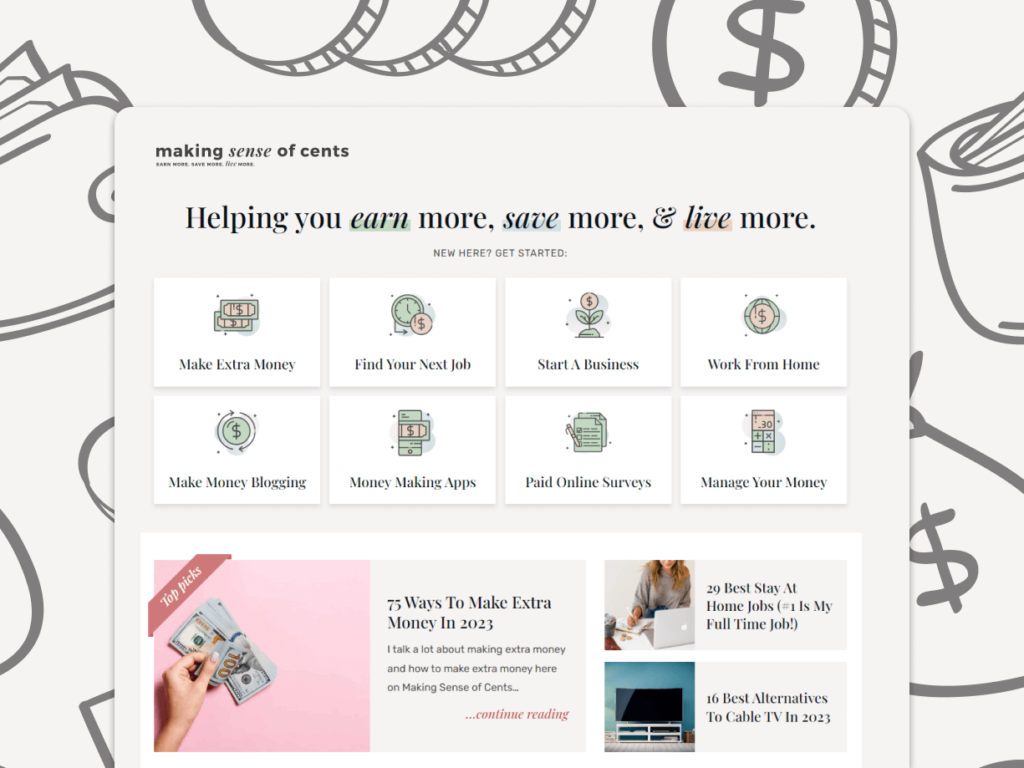
In addition, there’s a rise in blogs centered on the FIRE (Financial Independence, Retire Early) principle. This trend indicates that financial independence is a sought-after goal amongst readers and a profitable subject for money blogging. If you possess expertise in areas like budgeting, frugality, investing, or retirement planning, this niche can provide a robust platform for your money-making blog.
Here are some example niches within the personal finance and investing category:
- Budgeting for beginners
- Investing for millennials
- Retirement planning tips
- Real estate investment strategies
- Stock market analysis
- Cryptocurrency trends
- Frugal living hacks
- Credit score improvement
- Debt-free living
- Wealth building for women
- Tax planning advice
- Side hustles for extra income
- Financial independence journey
- Sustainable investing
- Family financial planning
Health and Fitness
As people increasingly prioritise their health and wellness, the health and fitness niche continues to flourish. In this extensive niche, you can explore everything from structured meal prep to dedicated workouts, connecting with diverse audiences focused on things like diet, mental health, yoga, or muscle gain.
Many health and fitness blogs, like ‘Fitness on Toast‘, masterfully serve their readers by providing beneficial, regimented meal prep ideas, enjoyable workouts, and wholesome meal plans – catering to everyone from cost-conscious foodies to dedicated fitness enthusiasts.

Whether your interest lies in body-weight training, vegan diets, or tips for staying fit in the midst of the COVID pandemic, there’s a space for you in this niche. Just remember that success in health and fitness content requires authenticity, evidence-backed details on workouts and meal prep, and a genuine desire to inspire your readers to reach their health goals.
Here are some example niches within the health and fitness category:
- Home workout routines
- Yoga and mindfulness
- Healthy meal planning
- Weight loss journeys
- Fitness for busy professionals
- Mental health awareness
- Nutritional supplements guide
- Personal trainer tips
- Vegan fitness lifestyle
- Overcoming chronic illness
- Running and marathon training
- Holistic health practices
- Senior fitness programs
- Pregnancy fitness
- Children’s health & nutrition
Food and Recipes
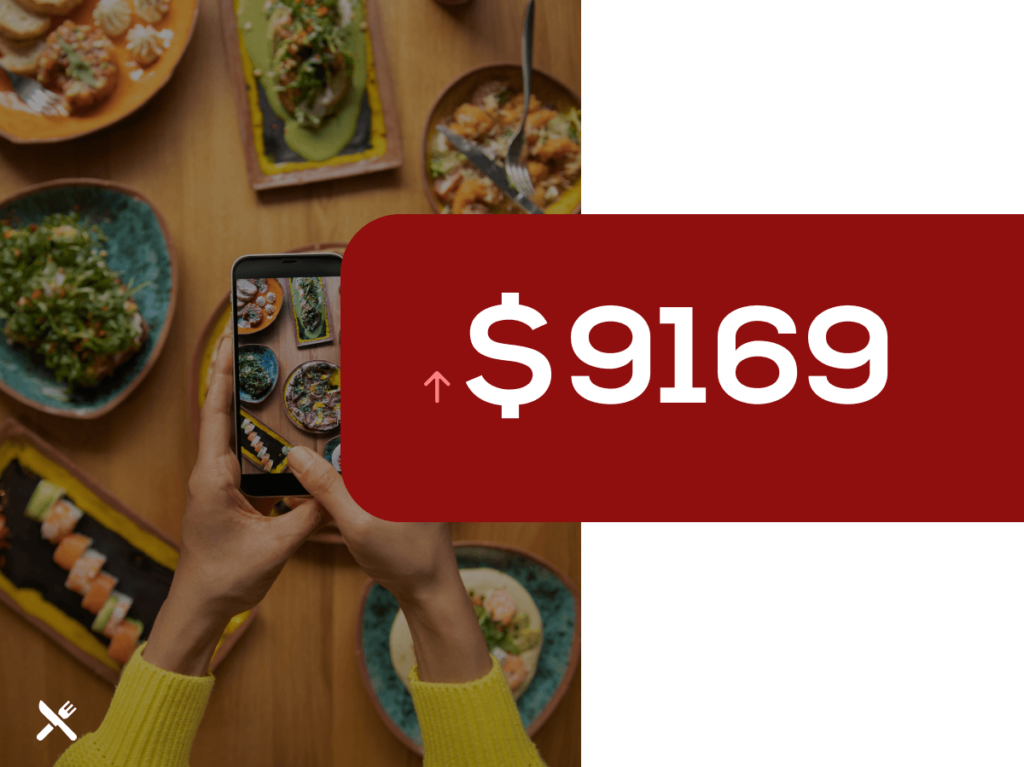
The food and recipes niche has always been a popular choice, and in 2023, it continues to evolve and charm audiences globally. With the rising popularity of cooking blogs, home cooks seeking new recipes, and gourmets hunting for the latest culinary trends, the audience for food-related online content widens and diversifies even more.
This niche invites aspiring bloggers to explore cooking and meal topics that ignite their passion. Are you devoted to veganism? The world of cooking blogs is filled with a massive audience interested in vegan recipes and a plant-based lifestyle. Or perhaps, you have a penchant for global cuisines. Here, a cooking blog that navigates “meals from countries far away” can whet readers’ appetites with a unique culinary globe-trotting adventure.

Best of all, a cooking blog can easily couple with other niches such as travel (imagine blogging about food tours!) or health (visualise featuring clean eating recipes). Just remember, your blog’s success roots in the originality and authentic passion for your chosen topic — these elements will make you shine brightly in this packed (yet delectably) catering to this ever-growing digital landscape!
Here are some example niches within the food and recipes category:
- Quick & healthy recipes
- Vegan cooking
- International cuisine explorations
- Baking from scratch
- Cooking on a budget
- Gluten-free living
- Meal prep guides
- Food photography tips
- Fine dining reviews
- Wine and cheese pairing
- Farm-to-table cooking
- Historical recipes and foods
- Gourmet coffee brewing
- Plant-based diet tips
- Fermentation and preserving
Lifestyle and Hobbies

In the lifestyle and hobbies niche, the opportunity for bloggers is vast. Likewise in the realm of interior design blogging and homesteading, there is a variety of topics to explore. From DIY crafting to home renovation, photography to painting, gardening to travel – the lists of subjects to delve into are endless, each catering to distinct readerships. One such thriving example is the blog ‘A Beautiful Mess‘ which curates content on crafts, recipes, home decor, and fashion.
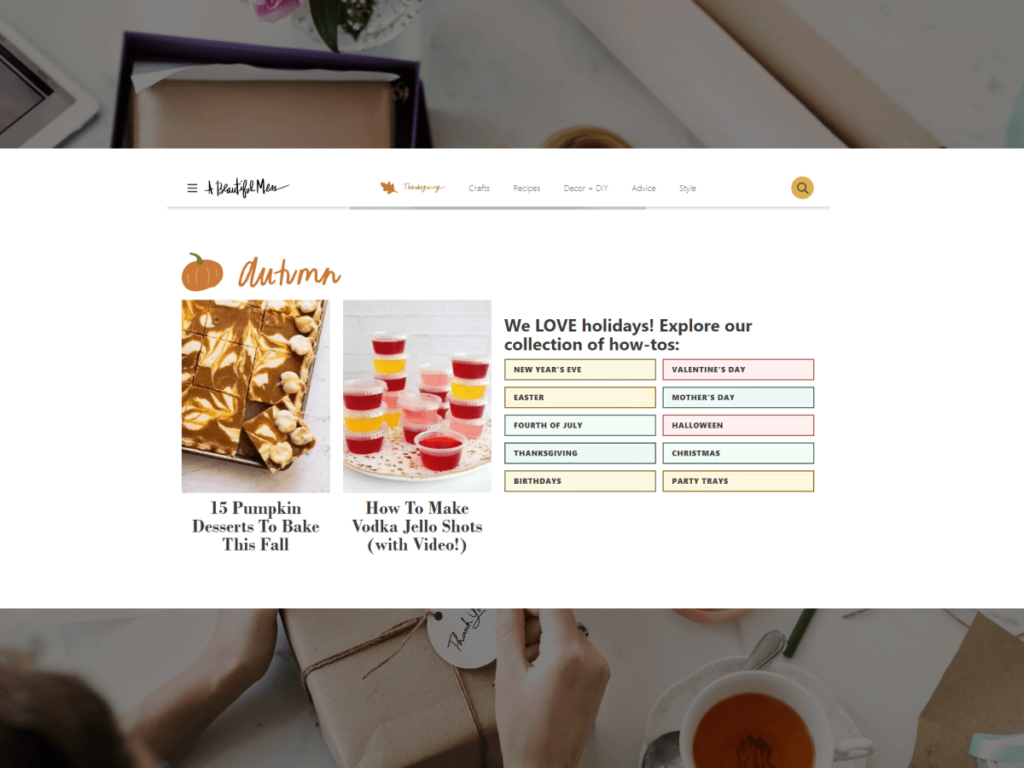
Be it an interior design blog reflecting your unique approach to home makeovers, or a blog detailing your journey towards homesteading, the key is to choose a sub-niche where you can provide unique value to your readers.
Here are some example niches within the lifestyle and hobbies category:
- Minimalist living
- DIY home projects
- Gardening and plant care
- Travel on a budget
- Book reviews and recommendations
- Crafting and upcycling
- Fashion on a budget
- Pet care and training
- Art and painting techniques
- Digital nomad lifestyle
- Photography tips & tricks
- Thrift shopping and vintage dinds
- Calligraphy and hand lettering
- Home organization hacks
- Board games and puzzles
Education and Self-development
The education and self-development niche is another profitable choice brimming with opportunity, especially with the prevalent trend of lifelong learning. With education being a future-proof blog topic that allows you to potentially sell online courses, you’ll not only cater to students but educators and anyone with an insatiable thirst for knowledge as well.
On the other hand, the wide spectrum of self-development topics includes everything from personal growth guides, emotional intelligence enhancement, to efficiency and productivity hacks, validating the need for a self-care blog. A notable example of success in this domain is ‘Mindful.org‘, a well-regarded self-care blog offering a variety of resources for personal growth and mindfulness.
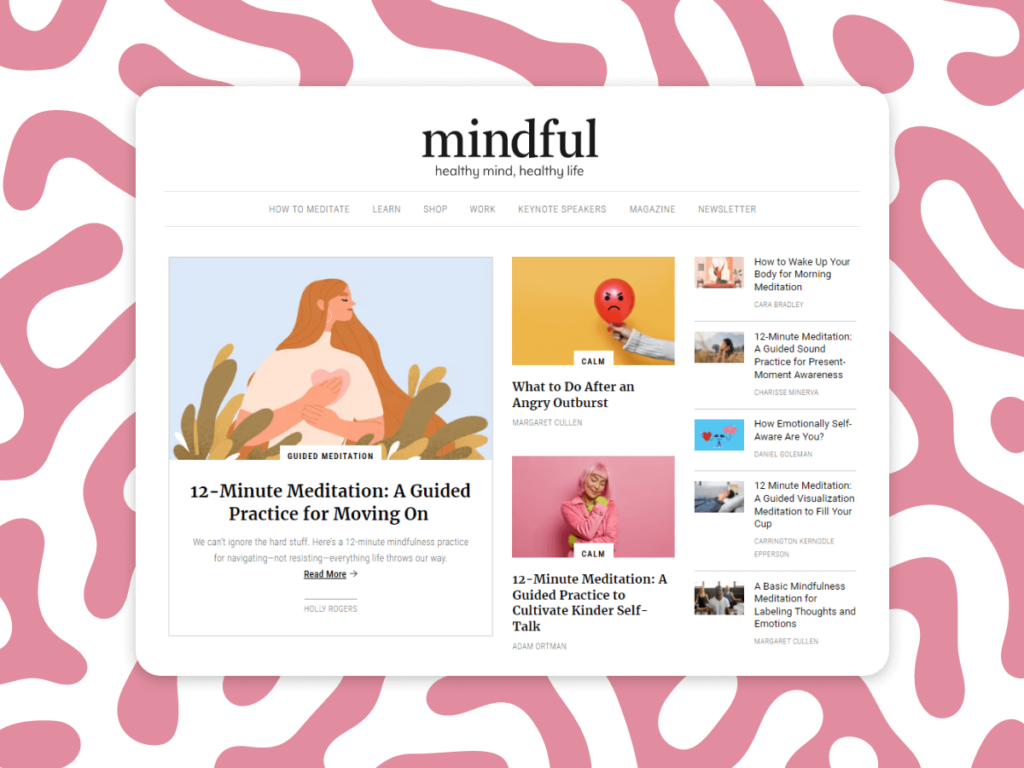
Remember though, with the importance of digital marketing in today’s world, ensuring your education blog’s content success will hinge upon maintaining credibility through well-researched content backed by reliable sources.
Here are some example niches within the education and self-development category:
- Language learning tips
- Online course reviews
- Time management strategies
- Leadership skills development
- Personal growth challenges
- Productivity hacks
- Mind mapping techniques
- Creative writing prompts
- Public speaking tips
- Learning through travel
- Career advancement strategies
- Emotional intelligence insights
- Speed reading techniques
- Parenting and education
- Philosophy and critical thinking
Technology and Gaming
In the digital age, the technology and gaming niche is thriving more than ever. Moreover, the potential for starting a gaming blog or a consumer electronics blog has piqued the interest of many, turning hobbies and passions into profitable pursuits. This niche is highly dynamic and diverse, with numerous avenues to explore based on your expertise and interest.
For technology, your blog, much like consumer electronics affiliates or apps developers, could review the latest gadgets, delve into significant trends like artificial intelligence, educate about cybersecurity, or provide software reviews and guides. Tech blogs like ‘The Verge‘, being a prime example of a successful website in this niche, have a strong following due to their comprehensive coverage of various technology-related topics.

In gaming, whether it’s reporting industry news, writing video game tutorials, or giving advice on how to monetise a gaming blog, this niche is seeing an upward trend, especially with the rise of Esports and streaming platforms like Twitch.
If you happen to be an avid gamer, this might be the perfect blogging opportunity for you. Just remember, like all consumer electronics and gaming updates, to keep up with the fast-paced nature of this industry to provide your readers with timely and relevant content.
Here are some example niches within the technology and gaming category:
- Latest tech gadgets reviews
- Mobile app recommendations
- Video game reviews
- Emerging tech trends
- Cybersecurity tips
- Virtual reality experiences
- Coding for beginners
- Tech entrepreneurship
- Gaming tutorials and tips
- Artificial intelligence insights
- Blockchain and its applications
- Home automation guides
- Drone photography
- E-sports and competitive gaming
- Social media strategies
Bonus Categories
Here are some bonus niches you can blog about:
- Sustainable living practices
- Local community events and news
- Alternative energy sources
- Space and astronomy
- Historical events and analysis
- Movie and TV show reviews
- Podcast recommendations
- Indie music exploration
- Humour and satire writing
- True crime and mystery
- Pop culture and trends analysis
Need even more blog ideas? Check out our article: WordPress Blog Examples: 30 Most Beautiful and Popular WordPress Blogs in 2023.
Brainstorming and Validating Your Blog Niche Ideas
Strategies for Idea Generation
Time to brainstorm your blog niche ideas. Here is an overview and some strategies you can apply:
- Mind Mapping: Create a visual representation of your thoughts, interests, and techniques, in essence a map of your ideas to generate more ideas. Start with a broad category, such as an aspect of dog behaviour, and generate subtopics around it.
- Explore Potential Content: Encourage a search for existing content in your interest areas. Look at popular blogs, YouTube channels, podcasts, or online forums like Reddit. What topics are they covering? Any best practices discovered?
- Keyword Research: There’s value in using keyword research tools like Semrush or Google’s Keyword Planner to find popular keywords in your niche.
- Social Media Trends: Leverage platforms like TikTok, Instagram, Facebook, Twitter, Pinterest, and LinkedIn to observe what topics and hashtags are trending.
- Real Conversations: Take note of problems and topics discussed by your friends, family, or colleagues. Observations can end up as a fantastic niche idea!
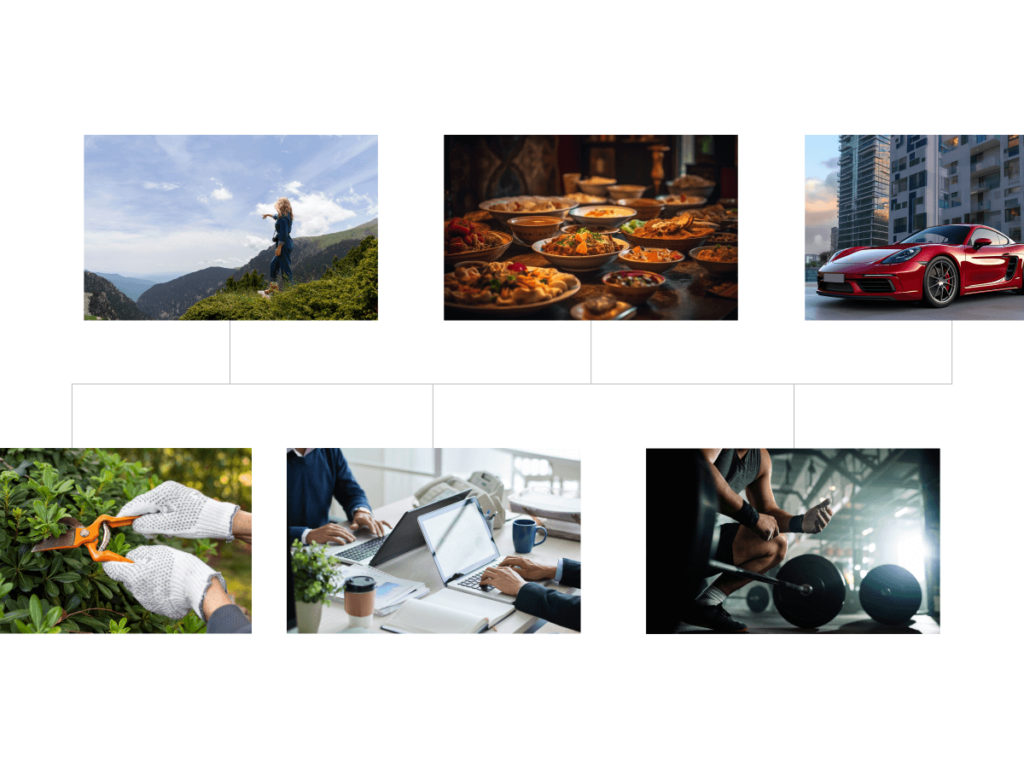
One more thing to remember, the goal is not to generate just a handful, but at least 50 blog post ideas for your niche. If you struggle to come up with enough ideas, it could be an indicator that the niche may not be the right fit for you.
Evaluating the Profitability and Longevity of Your Chosen Niche
Once you’ve brainstormed possibilities for your blog niche, it’s time to evaluate their potential profitability and longevity. Ask yourself these integral questions:
- Search Trend: Are search volumes for your niche topic growing? Tools like Google Trends can be beneficial in tracking the interest over time.
- Monetisation Potential: As the eCommerce world and affiliate income streams continue to evolve, does your niche fit these changes? Does it allow for practical monetisation strategies like affiliate marketing, sponsored posts, or selling products/services? Are there potential ecommerce opportunities or affiliate income channels within your niche?
- Audience Demand: Is there a significant paying audience for your blog topic? Understanding the size and level of engagement of the potential audience can help gauge profitability.
- Competition: Is the contest in your blog niche too steep or manageable? Keep in mind, some competition is beneficial; it indicates demand. However, excessive rivalry might make it challenging for your blog to distinguish itself.
- Passion and Expertise: Is this a topic you’re passionate about and have expertise in? Consistency is key in blogging, and it’s easier when you genuinely enjoy what you blog about.

Judging these factors will help you make an informed decision regarding the success and growth potential of your chosen blog niche.
Coping with Competition in Your Choosen Niche
Assessing the Level of Competition
Assessing the level of competition is crucial as it can influence your niche’s potential for success. Here are some efficient ways to measure competition:
- Google Search: Run some Google searches to see the top-ranking sites for popular search terms in your niche. It’s vital to study whether the first search page is dominated by large companies or if there are smaller sites that claim a fair share of space.
- SEO Tools: Use reliable SEO tools such as Moz, Semrush, or even the free Ahrefs browser extension. These tools help analyse the competitive landscape and provide vital insights on the difficulty of ranking for specific keywords tied to your niche.
- Social Media Presence: Evaluate the presence and engagement of blogs in your niche on social media platforms. A high engagement rate and increased followers often signal high competition.

While competition might seem intimidating, remember that a certain degree of competition is beneficial as it validates the presence of an audience interested in your niche. The key lies in maintaining a balance – your niche should harbor enough competition to corroborate its viability, but not so much that standing out becomes a Herculean task.
Differentiating Your Blog from Others
Differentiating your blog from others is crucial in standing out amidst the competition. Highlighting the nomad life or the subtleties of being a digital nomad could be a unique angle. You’ll want to offer your readers something they can’t find elsewhere, or perhaps present common information in an unparalleled manner. Here’s how you can achieve that:
- Unique perspective – Stuffed with unparalleled insights about travel deals or travel hacks? Share your unique perspective on common topics. Your individual outlook and experiences as a nomad could be the refreshing change readers are looking for.
- Exceptional quality – Deliver top-notch content with exhaustive research and engaging storytelling. High-quality content on being a digital nomad or living abroad can trump hundreds of mediocre posts on the same topic.
- Innovative format – Change up the format of your posts. Try incorporating infographics, video content, slide shows, or Q&A sessions to make your content more engaging.
- Niche Down – Narrowing down your subject area to cater to a more specific audience can differentiate your blog. For instance, instead of being another travel blog, you could be a blog focusing on the nomadic lifestyle or RV life.
Remember, your blog’s uniqueness doesn’t have to solely lie in its subject matter. How you deliver that content can equally set you apart from the crowd!

Exploring Blog Monetisation Avenues
Making Money Through Affiliate Programs
Affiliate programs can be a lucrative strategy for monetising your blog. In simple terms, you promote a product or service on your blog and earn a commission for every sale made through your referral.
Platforms such as ShareASale, ClickBank, and Amazon Associates are popular for their vast network of companies looking for affiliates. If your niche is specific, you might also find affiliate programs tailored to your field.
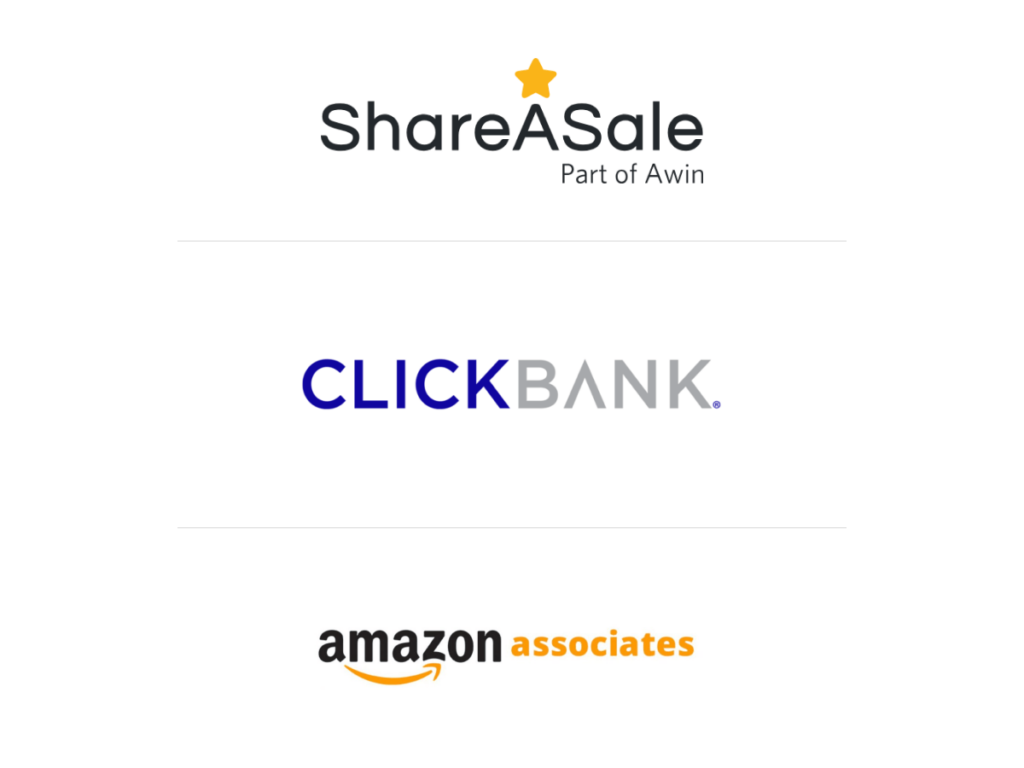
To make the most out of affiliate programs:
- Promote products that align with your content and that your audience will find useful. Authenticity helps build trust.
- Include calls to action (CTAs) to encourage clicks on your affiliate links.
- Be transparent about your affiliations to maintain your readers’ trust.
Remember, successful affiliate marketing requires time, patience, and marketing skills. But when done right, it could become a steady revenue stream for your blog.
Selling Your Own Products or Services
Selling your own products or services is another excellent way to monetise your blog, and it can sometimes bring in higher income than other methods. This is also a crucial part of running a blogging business. You can sell physical products, digital goods, or even offer a service. Here are some entrepreneur content ideas based on your niche:
- Ebooks or Courses: If you blog about a topic you’re knowledgeable in (like personal finance or digital marketing), you can create an eBook or online course.
- Physical Goods: If your blog focuses on something tangible like crafting or photography, you could sell your handmade crafts or prints.
- Consulting/Coaching: If you have professional expertise in areas like career coaching or personal fitness training, offering your services can be a profitable extension of your blog.
For example, Digital Photography School does not only provide valuable content but also sells photography-related ebooks and courses, dedicating a part of their blogging business to this venture.
Remember to ensure your products or services align with your blog’s niche and meet an existing need or desire within your audience for the best results.
Advertising and Sponsored Posts
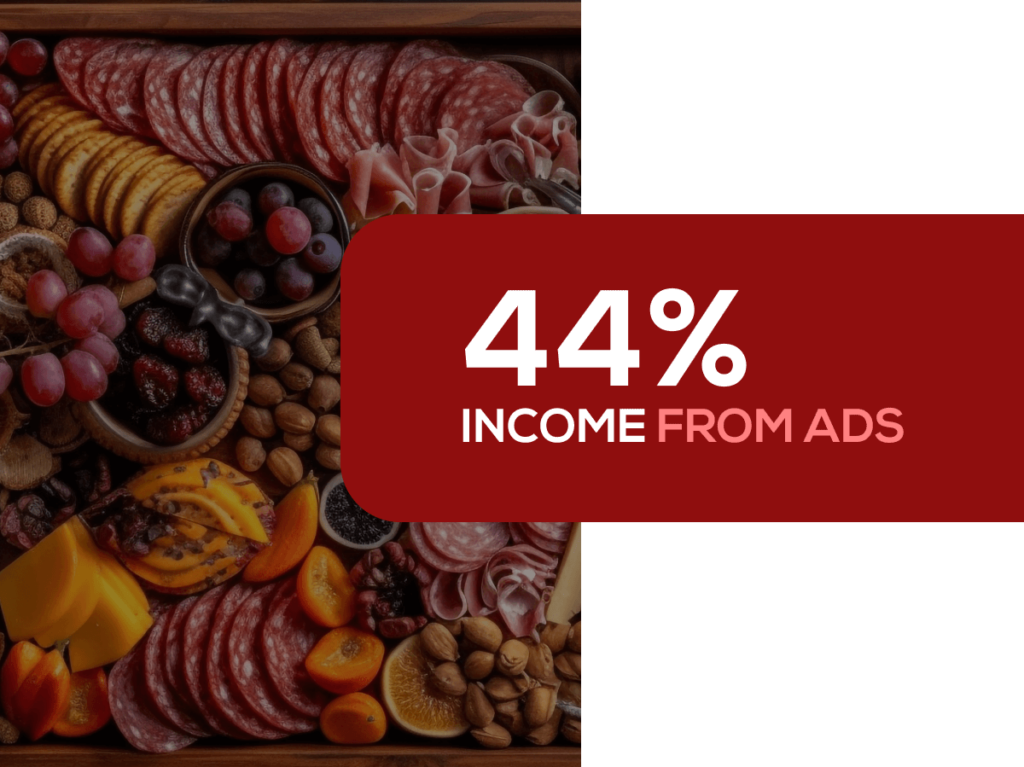
Advertising and sponsored posts provide another viable route to monetise your blog. Simultaneously, incorporating a targeted email campaign can further help to monetise your efforts, reaching out directly to your audience can do wonders.
Advertising: This typically involves displaying ads on your blog. Services like Google AdSense make it easy to start, but you’ll need significant traffic to make a substantial income. One actionable strategy is to grow your email list, providing consistent updates, and custom content directly to the reader’s email address.
Read out article “How To Insert Ads On WordPress: Monetising Your Blog With Adsense And Advertising” for more information.
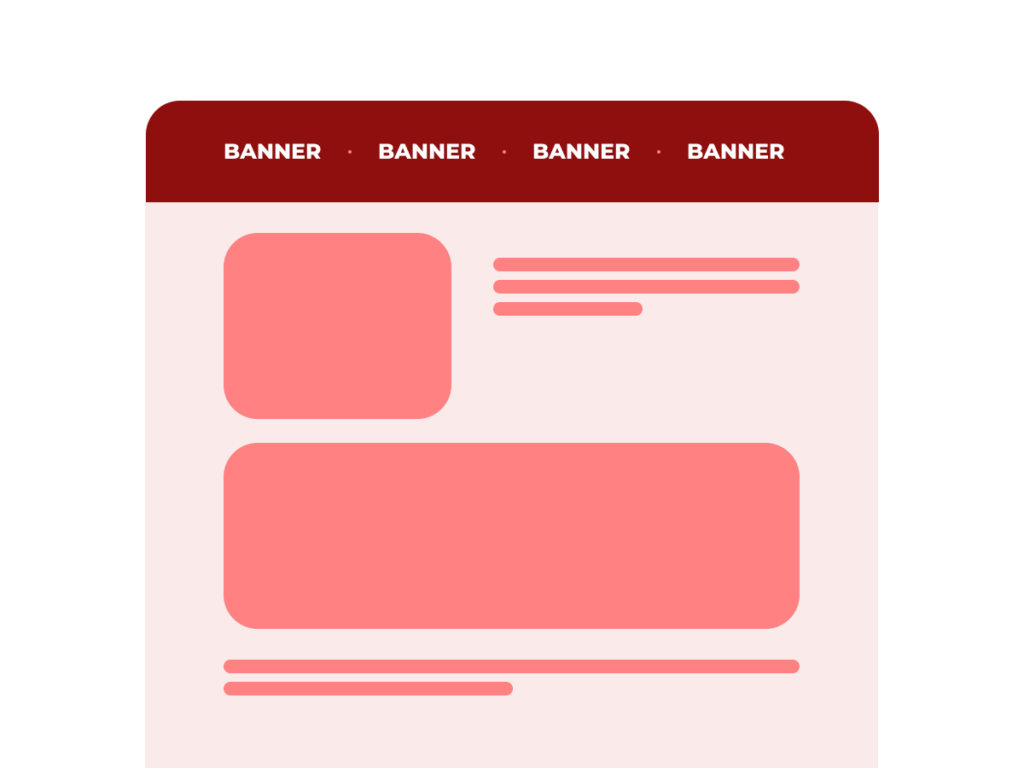

Sponsored Posts: These posts are essentially content that a company pays you to write about their product or service. They’re a popular choice for bloggers because they can be profitable, but transparency with your audience is crucial.

While these methods can be lucrative, it’s essential to avoid littering your blog with ads or turning it into a sales pitch platform. Too many advertisements or overly promotional content can distract and annoy your readers, potentially hurting your blog in the long run. Pairing ads and sponsored posts with an engaging email campaign can, however, strike a balance and remain authentic to your readers.
Learn more in our article: How to Monetise WordPress Blog: 12 Ways to Make Money Online Blogging in 2023.
Expanding Your Niche Over Time
Diversifying Your Blog Topics

Over time, as you become more confident and your blog begins to grow, you might want to consider diversifying your blog topics. Consider a travel guide blog as an example. This expansion can help attract a wider audience by including attractions of various places, thus avoiding your blog from being monotonous. Here’s how to do it:
- Sub-Niches: Look for sub-niches that align with your primary topic. For example, if your blog’s main focus is a travel guide, you could cover sub-niches like sustainable travel or cultural attractions.
- Related Niches: Consider niches that might logically connect with your current one. Imagine you blog about eco-friendly travels; your readers may also be interested in learning about vegan restaurants in the various attractions they visit.
However, when diversifying, ensure the new topics still appeal to your target demographic. Conducting reader surveys or studying your most popular posts can provide insights into what additional content will gain traction. This could include curated city itineraries to help visitors hit all the worthy attractions in a given timeframe. Remember, the goal is to grow your blog, maintain focus and relevance, keeping your audience engaged and returning for more.
Adopting New Trends Within Your Niche

Riding the wave of new trends within your niche is another great way to expand your blog over time. For instance, a meditation blog can tap into the meditation population by incorporating trending topics into their content. This can attract new readers and provide fresh, up-to-date insights for your regular followers. Here’s how you can do it:
- Stay Updated: Follow industry news from well-known blogs, subscribe to relevant newsletters, and join online communities. These platforms will help you to stay informed about the latest trends.
- Use Trend Tools: Tools like Google Trends or BuzzSumo can inform you about what’s currently ‘hot’ within your niche, such as popular meditation techniques.
- Collaborate: Involve guest bloggers or collaborate with influencers within your niche. They can bring new ideas and trends to your blog.
By consistently adopting new trends, like those in the meditation field, you not only keep your blog relevant and fresh, but you create multiple entry points for new readers to discover your blog.
However, while chasing trends, remember to stay true to your blog’s core purpose. Not every buzzworthy element may be appropriate or valuable for your specific audience.
Frequently Asked Questions
How Broad or Narrow Should My Blog Niche Be?
Your blog niche should be specific enough to target an engaged audience, yet broad enough to have space for diverse and abundant content. Whether you’re looking at creating a dog training blog or a parenting blog, the key is to strike a balance. If your focus is too narrow, like focusing only on toy poodle training, you might struggle with limited content ideas and audience size. If it’s too broad like a general pet care blog, you could find it hard to build a focused community or stand out amidst competitors. The same applies to diverse blog niches from wedding planning to beauty blogs.
Your chosen niche should resonate with the ‘right’ audience, instead of trying to appeal to ‘everyone’. For instance, focusing on eco-friendly parenting practices, can help you tap into a specific reader demographic – parents who want to raise their kids in an eco-friendly way. Similarly, a niche focusing on the luxury travel experience like art hotel reviews or glamping adventures, can attract an audience that’s passionate about high-end travel.
Can I Change My Blog Niche Later On?
Yes, you can change your blog niche later on. Say, for instance, you delve into the world of homeschooling if it aligns with your areas of interest or audience’s needs. You may also explore other areas like a lifestyle blog, fashion blog, or travel blog. Regardless, a significant shift, such as moving towards a homeschooling blog, may necessitate a careful content transition plan to retain your existing readers while attracting new ones. You might also need to revisit your blog’s branding, social media marketing, and SEO strategy to reflect this new focus on homeschooling.
Remember, even if you decide to change your niche, your knowledge and experience from the previous niche don’t go to waste – they offer useful insights for the new one, potentially accelerating its growth in areas like online learning, homeschooling, and test preparation.
Is It Possible to Manage Multiple Niches On One Blog?
While it is possible to manage multiple niches on one blog, it is generally not recommended, especially for beginners. An explosion of categories like a relationship blog, health, or finance can dilute your blog’s focus, potentially confusing your audience and making it tougher for your blog to rank on search engine result pages.
However, if you wish to cover multiple areas, consider them as sub-niches under a broader field. For example, a ‘Lifestyle’ blog could cover sub-niches such as ‘Home Decor’, ‘Budgeting’, ‘Healthy Recipes’, and perhaps even a relationship blog.
Remember that maintaining quality content across several niches can be demanding, so make sure you have the capacity and expertise to manage it. Craft your relationship blog to be relatable and empathetic for optimal resonance with readers.
Sources:
[1] RankIQ: https://www.rankiq.com/most-profitable-blog-niches-study/
Disclaimer
Some of the links in this post are affiliate links. This means if you click on the link and purchase the service, we may receive an affiliate commission at no extra cost to you. Rest assured, we only recommend products we believe will add value to our readers.
Submit An App
Seen a cool app you think we should review? Submit your recommendation using our form.


